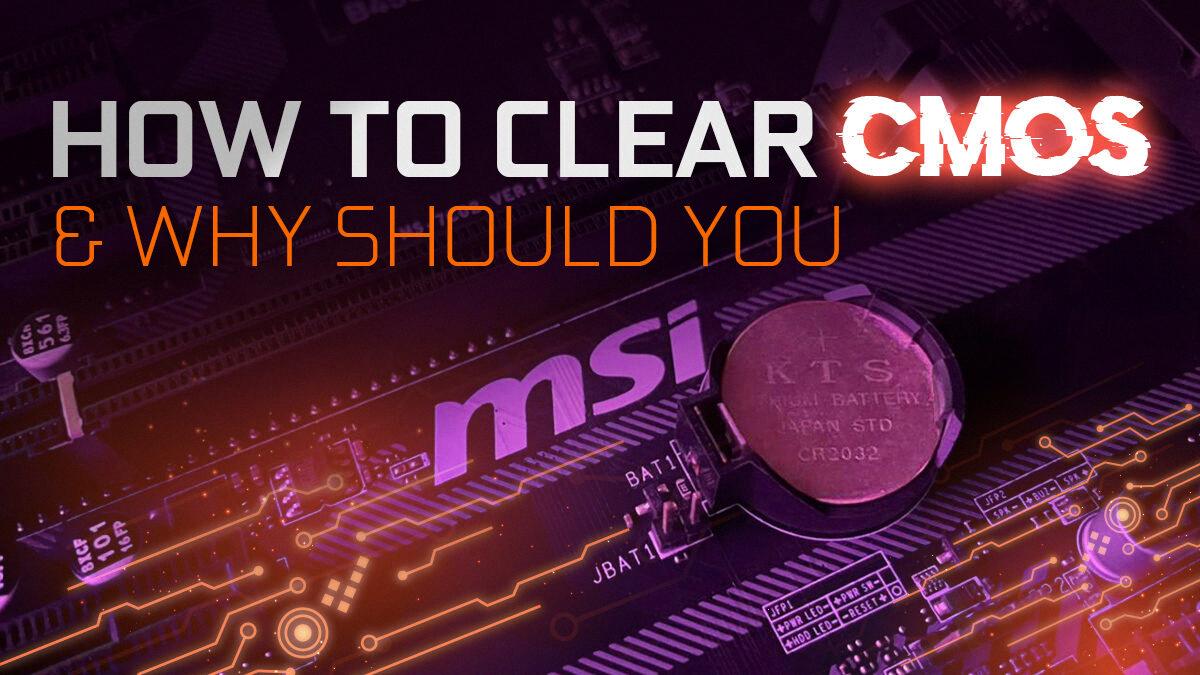Clearing the CMOS: Understanding the Purpose and Process
Have you ever encountered issues with your computer that seem to be related to the BIOS settings? Or perhaps you’ve experienced power failures or made changes to your hardware that have caused unexpected problems? In such cases, clearing the CMOS (Complementary Metal-Oxide-Semiconductor) might be the solution you need. In this article, we will delve into the purpose and process of clearing the CMOS, so you can understand its significance and how it can help resolve certain computer issues.
But first, let’s clarify what the CMOS is and why it matters. The CMOS is a small, battery-powered chip located on your computer’s motherboard. It stores important information about your system’s configuration, such as the date, time, and location settings, as well as the BIOS settings. These settings control how various hardware components interact with each other and the operating system. In essence, the CMOS acts as a bridge between the hardware and software, ensuring smooth communication and functionality.
Now, why would you need to clear the CMOS? Well, there are several scenarios where this might be necessary. One common situation is when you encounter issues with your BIOS settings. If you’ve made changes that have caused instability or unexpected behavior in your system, clearing the CMOS can revert the BIOS settings back to their default state. This can help resolve compatibility issues or conflicts that may have arisen due to misconfigured settings.
Another instance where clearing the CMOS is beneficial is when you experience power failures or sudden shutdowns. In such cases, the CMOS may become corrupted or lose power, causing the BIOS settings to become unstable. Clearing the CMOS can reset these settings, allowing your computer to boot up properly and function as intended.
Additionally, if you’re planning to sell or give away your computer, performing a CMOS reset is recommended. This ensures that any customized settings or personal information stored in the CMOS are wiped clean, providing a fresh start for the new user.
So, how do you actually clear the CMOS? The process may vary slightly depending on your computer’s make and model, but the general steps are as follows:
1. Shut down your computer and unplug it from the power source.
2. Open your computer’s case to gain access to the motherboard.
3. Locate the CMOS battery, which is typically a small, silver coin-shaped battery.
4. Carefully remove the CMOS battery from its slot. You may need to use a small screwdriver or your fingers to gently lift it out.
5. Wait for a few minutes to ensure that any residual power in the system dissipates.
6. Reinsert the CMOS battery back into its slot, making sure it is properly seated.
7. Close the computer case and plug the power source back in.
8. Power on your computer and check if the CMOS has been successfully cleared. You may need to reconfigure the BIOS settings if they have reset to their defaults.
Remember to consult your computer’s manual or manufacturer’s website for specific instructions tailored to your system.
Clearing the CMOS can be a useful troubleshooting step when encountering BIOS-related issues, power failures, or when preparing to sell your computer. By resetting the CMOS, you can restore the default settings and resolve problems caused by misconfigurations or instability. Just remember to follow the proper steps and consult your computer’s documentation for guidance.
Now that you understand the purpose and process of clearing the CMOS, you can confidently tackle any related issues that may arise and ensure the smooth operation of your computer system.
Will Clearing The CMOS Delete My Files?
Clearing the CMOS (Complementary Metal-Oxide-Semiconductor) will not delete your files. The CMOS is a small amount of memory on the motherboard that stores the BIOS (Basic Input/Output System) settings. When you clear the CMOS, you are essentially resetting the BIOS back to its default settings.
Clearing the CMOS involves either removing the CMOS battery or using a jumper on the motherboard to reset the memory. This process does not affect the data stored on your hard drives, including your personal files. The CMOS only holds information about hardware settings, such as the system clock, boot order, and other BIOS configurations.
It’s important to note that while clearing the CMOS won’t delete your files, it may reset some BIOS settings that could potentially impact your system’s functionality. After clearing the CMOS, you may need to reconfigure certain settings, such as enabling or disabling certain features or adjusting the boot order.
To summarize:
– Clearing the CMOS does not delete your files.
– The CMOS stores BIOS settings, not personal data.
– Clearing the CMOS resets the BIOS settings to default.
– You may need to reconfigure BIOS settings after clearing the CMOS.
Please remember to back up your important files regularly to ensure their safety, but clearing the CMOS itself does not pose a risk to your data.

What Happens When You Remove CMOS?
When you remove the CMOS (BIOS) battery from your console, several things can happen:
1. Resetting BIOS Settings: The CMOS battery stores the BIOS settings for your console. By removing the battery, these settings are reset to their default values. This means that any customization or changes made to the BIOS settings will be lost, and the console will revert back to the original factory settings.
2. Date/Time/Location Reset: The CMOS battery also keeps track of the date, time, and location settings for your console. When you remove the battery, these settings will be reset to their default values. You will need to manually set the correct date, time, and location again.
3. Loss of Persistent Memory: The CMOS battery provides power to the CMOS chip, which stores important information for the console. This includes hardware configuration details, such as the type and amount of memory installed, as well as other system-specific settings. Removing the battery will cause this persistent memory to be lost, and the console will have to rediscover and reconfigure its hardware components.
4. BIOS Password Reset: In some cases, removing the CMOS battery can also reset any BIOS passwords that have been set. This can be useful if you have forgotten the BIOS password and need to regain access to your console.
Removing the CMOS battery is a way to reset the BIOS settings, date/time/location settings, and potentially BIOS passwords on your console. However, it should be done with caution as it will result in the loss of any customization or changes made to the BIOS settings.
What Does Clearing BIOS Do?
Clearing the BIOS, also known as a BIOS reset or BIOS clear, is the process of restoring a computer’s BIOS settings to their original factory defaults. The BIOS (Basic Input/Output System) is a firmware that is embedded on a computer’s motherboard. It is responsible for initializing hardware components and providing the necessary instructions for the operating system to start.
When you clear the BIOS, you are essentially wiping out any custom settings that may have been made, and reverting back to the default configuration. This can be useful in a number of situations:
1. Fixing hardware issues: Sometimes, changes in BIOS settings can cause hardware problems. Clearing the BIOS can help resolve these issues by resetting all settings to their default values.
2. Resolving boot problems: If your computer is experiencing boot problems, such as not starting up properly or getting stuck at the BIOS screen, clearing the BIOS may help. It can eliminate any incorrect or conflicting settings that may be preventing the system from booting.
3. Recovering from failed BIOS updates: Occasionally, BIOS updates can go wrong and result in a non-functional system. Clearing the BIOS can help recover from such failures and allow you to re-flash the BIOS with a working version.
4. Removing BIOS passwords: In some cases, clearing the BIOS is necessary to remove any BIOS passwords that have been set. This can be useful if you have forgotten the password or if you have acquired a used computer that is locked with a BIOS password.
To clear the BIOS, you typically need to perform a specific procedure, which may involve removing a jumper or battery from the motherboard, or using a BIOS reset button. The exact steps can vary depending on the computer’s make and model, so it’s important to consult the motherboard or computer manual for specific instructions.
It’s worth noting that clearing the BIOS will reset all settings, including those related to hardware configurations, boot order, and security features. After clearing the BIOS, you may need to reconfigure these settings to match your particular setup.
Clearing the BIOS restores a computer’s BIOS settings to their original factory defaults. It can help resolve hardware issues, boot problems, recover from failed BIOS updates, and remove BIOS passwords. However, it’s important to be cautious when performing a BIOS reset and to follow the specific instructions for your computer model.
Do You Need To Clear CMOS When Changing RAM?
You do not need to clear the CMOS when changing RAM in a computer. Clearing the CMOS (Complementary Metal-Oxide-Semiconductor) is typically done when there are issues with the BIOS (Basic Input/Output System) settings or if you want to reset the BIOS to its default configuration.
Changing or upgrading the RAM (Random Access Memory) in a computer does not require resetting the CMOS. The process of adding or removing RAM modules is relatively simple and straightforward. However, it is important to follow certain precautions to ensure the safety of the computer and the components.
Here are the steps to change or upgrade RAM without resetting the CMOS:
1. Shut down the computer: Before working on any internal components, make sure to shut down the computer properly.
2. Unplug the computer: Once the computer is shut down, unplug it from the AC power source. This will prevent any electrical accidents and ensure your safety.
3. Ground yourself: To avoid any potential damage from static electricity, it is recommended to ground yourself by touching a metal surface before touching any internal components.
4. Open the computer case: Depending on your computer model, you may need to remove screws or use a latch to open the case. Refer to the computer’s manual for specific instructions.
5. Locate the RAM slots: The RAM slots are usually located near the CPU (Central Processing Unit) and are easily identifiable. They are long, thin slots with small clips on either side.
6. Remove the old RAM: Gently press down on the clips on both sides of the RAM module until it pops up. Carefully remove the module from the slot, holding it by the edges without touching the gold pins.
7. Insert the new RAM: Take the new RAM module and align it with the slot. Make sure the notch on the module matches the notch on the slot. Firmly press down on both ends of the module until the clips snap into place.
8. Close the computer case: Once the new RAM is installed, carefully close the computer case and secure it with screws or latches as required.
9. Plug in the computer and power it on: After ensuring that everything is properly secured, plug the computer back into the AC power source and power it on. The computer should recognize the new RAM automatically.
Remember, clearing the CMOS is a separate process and is not necessary when changing or upgrading RAM in a computer. It is only required when there are specific issues related to the BIOS settings.
Conclusion
Clearing the CMOS is a process that resets the BIOS settings to their original factory defaults. This can be necessary in situations where a computer is experiencing issues or when new hardware is installed. By removing the CMOS battery or using a CMOS reset jumper, the persistent memory that stores BIOS settings is wiped, causing the system to revert to its default configuration.
It is important to note that clearing the CMOS does not affect the data on the hard drives, such as personal files or applications. The process only resets the BIOS settings and does not have any impact on the stored data.
Performing a BIOS reset is a recommended step when selling a PC, as it ensures that the system is running on its original settings and eliminates any potential customization or modifications made by the previous user.
It is worth mentioning that adding or removing RAM from a computer does not require a CMOS reset. However, it is important to shut down the computer and unplug it from AC power before touching the RAM to avoid any electrical damage. After installing or removing the RAM, the computer can be plugged in and powered on as usual.
Clearing the CMOS is a simple yet effective way to restore a computer’s BIOS settings to their default state. It is a useful tool for troubleshooting issues and ensuring that the system is running on its original configuration.







